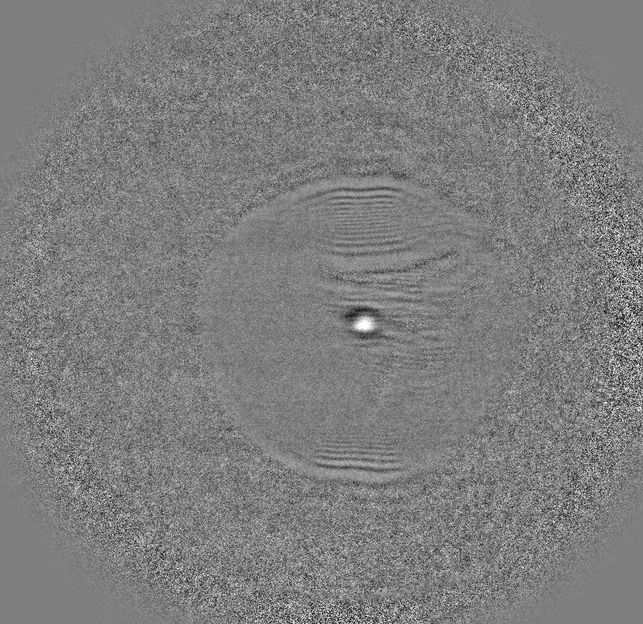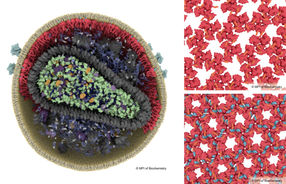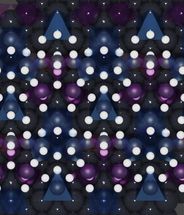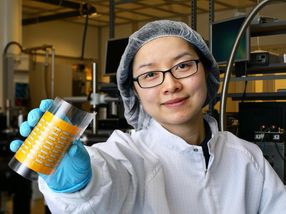PETRA III provides new method for determining the melting temperature at high pressure
An international research team from DESY, the Lawrence Livermore National Laboratory, the University of Edinburgh and the Karlsruhe Institute of Technology has developed a novel method to accurately determine the melting temperature of opaque materials using X-ray phase-contrast imaging and X-ray diffraction in a laser-heated diamond stamp cell at pressures up to 500,000 bar and temperatures up to 4000 Kelvin. The team led by Emma Ehrenreich-Petersen from DESY and Earl Francis O'Bannon from Lawrence Livermore National Laboratory developed the method at beamline P02.2 at DESY's high-energy X-ray source PETRA III.

With the method developed at PETRA III, the incipient melting process in platinum (in the center of the image) can be followed precisely.
DESY, Hanns-Peter Liermann
With the method developed at PETRA III, the incipient melting process in platinum (in the center of the image) can be followed precisely. Image: DESY, Hanns-Peter LiermannDetermining the melting of opaque materials at high pressures has been a major challenge for decades. Many approaches to this have been developed in recent decades since laser-heated diamond stamp cells were introduced to achieve high pressures and temperatures. These fist-sized high-pressure devices consist of two opposing modified diamonds between which the sample is compressed. It can generate pressures that are higher than the pressure inside the earth. The sample - in this case a metal foil - can be heated through the transparent diamonds using very powerful infrared lasers that shine onto the sample from both sides of the diamonds. "It is very difficult to detect the first appearance of very small amounts of melt using imaging techniques or X-ray diffraction on the sample. In previous studies, this led to discrepancies in the determination of the melting temperature," explains first author Emma Ehrenreich-Petersen from DESY. "In our study, we combine the established technique of X-ray phase-contrast imaging with X-ray diffraction and apply it to the laser-heated diamond stamp cell. This allows us to detect the smallest phase contrasts between the solid and the liquid sample."
"The advantage of this approach is that you don't have to melt the entire sample, as this setup can resolve volumes as small as one micrometer," explains project leader Earl Francis O'Bannon from Lawrence Livermore National Laboratory. "We tested this novel approach on the PETRA III Extreme Conditions Beamline P02.2 by determining the melting line of platinum up to a pressure of 500,000 bar and a temperature of 4000 Kelvin. We have shown that the technique is much more sensitive in determining the onset of melting than any other previous technique."
"The newly developed approach is a good example of how interdisciplinary research groups, such as the high-pressure user groups at Lawrence Livermore National Laboratory and the University of Edinburgh, Christian Schroer's imaging group at PETRA III, the Karlsruhe Institute of Technology and the beamline team at P02.2, are working together to develop a novel method that will help researchers solve some of the open scientific questions," explains Hanns-Peter Liermann, head of the Extreme Conditions Beamline P02.2. "We are certain that this approach will fundamentally change the way the onset of melting is determined in the future. With new 4th generation light sources such as the ESRF-EBS and the APS-U offering X-ray beams of equal or even higher coherence than PETRA III, this approach will gain importance as it improves sensitivity and imaging quality. It is therefore important to upgrade our X-ray source to PETRA IV: it will be the only light source in the world that offers almost a factor of 1000 higher coherence at high energies, further improving the resolution of the technique."
Note: This article has been translated using a computer system without human intervention. LUMITOS offers these automatic translations to present a wider range of current news. Since this article has been translated with automatic translation, it is possible that it contains errors in vocabulary, syntax or grammar. The original article in German can be found here.
Original publication
Emma Ehrenreich-Petersen, Bernhard Massani, Thea Engler, Olivia S. Pardo, Konstantin Glazyrin, Nico Giordano, Johannes Hagemann, Daniel Sneed, Timofey Fedotenko, Daniel J. Campbell, Mario Wendt, Sergej Wenz, Christian G. Schroer, Mathias Trabs, R.Stewart McWilliams, Hanns-Peter Liermann, Zsolt Jenei, Earl F. O’Bannon; "X-ray phase contrast imaging and diffraction in the laser-heated diamond anvil cell: A case study on the high-pressure melting of Pt"; Results in Physics, Volume 69

























































